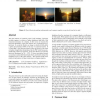Free Online Productivity Tools
i2Speak
i2Symbol
i2OCR
iTex2Img
iWeb2Print
iWeb2Shot
i2Type
iPdf2Split
iPdf2Merge
i2Bopomofo
i2Arabic
i2Style
i2Image
i2PDF
iLatex2Rtf
Sci2ools
APGV
2008
ACM
2008
ACM
Brightness of the glare illusion
The glare illusion is commonly used in CG rendering, especially in game engines, to achieve a higher brightness than that of the maximum luminance of a display. In this work, we measure the perceived luminance of the glare illusion in a psychophysical experiment. To evoke the illusion, an image is convolved with either a point spread function (PSF) of the eye or a Gaussian kernel. It is found that 1) the Gaussian kernel evokes an illusion of the same or higher strength than that produced by the PSF while being computationally much less expensive, 2) the glare illusion can raise the perceived luminance by 20 - 35%, 3) some convolution kernels can produce undesirable Mach-band effects and thereby reduce the brightness boost of the glare illusion. The reported results have practical implications for glare rendering in computer graphics. CR Categories: I.3.8 [Computer Graphics]: Applications-[I.4.9]: Image processing and computer vision--Applications
| Added | 12 Oct 2010 |
| Updated | 12 Oct 2010 |
| Type | Conference |
| Year | 2008 |
| Where | APGV |
| Authors | Akiko Yoshida, Matthias Ihrke, Rafal Mantiuk, Hans-Peter Seidel |
Comments (0)

